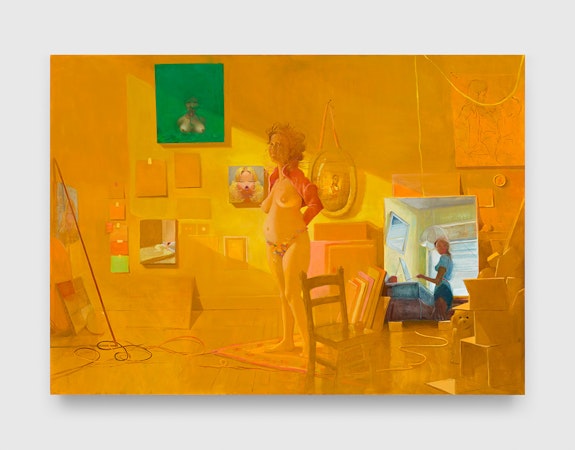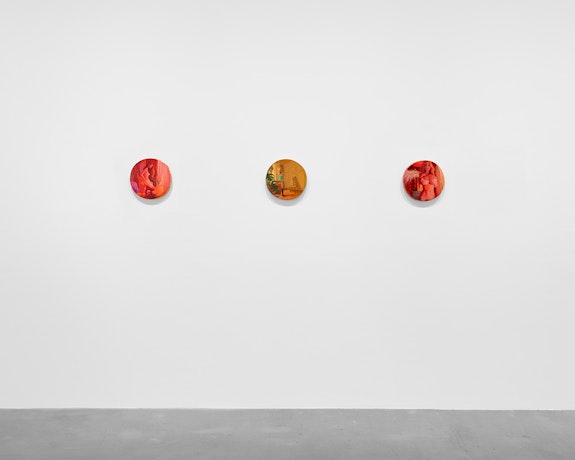ArtSeen
Lisa Yuskavage: Rendez-vous

On View
David ZwirnerRendez-vous
June 9–July 29, 2023
Paris
Every time I see a Lisa Yuskavage exhibition, I’m excited to discover the passages of pure painting that the artist permits herself. In Rendez-vous, Yuskavage’s first solo show in Paris, there are such moments in the striped-and-scraped socks that the artist-model wears in The Artist’s Studio (2022), in the dollops of pigment lined up on a wheeled work table in Big Flesh Studio (2022), and—most delectably—in the lick of an apple that curls up toward a listless model in the lower right-hand corner of the same painting. The coil, which mirrors an improbably buoyant lock of her hair, seems to yearn for the figure, even as she looks elsewhere, perhaps to pine for something or someone else.
That apple suggests how difficult it is to separate moments of paint handling from Yuskavage’s other decisions, for even as I describe it in terms of medium specificity, there are compositional elements and narrative and psychology to consider. The incline of the apple’s twist and model’s ringlet echo lower-left-to-upper-right diagonals throughout the canvas, including the model’s arm and leg as well as those of her companion, an easel, the leg and back of an outlined woman represented in a picture within the picture, the right arm of the painting’s one male figure (though we can identify his gender only speculatively from Yuskavage’s other paintings), and, most enthusiastically, the lean of a daisy poking hopefully from a bouquet of flowers. And we can already see where the double-entendres might go, what with the languid nudes and alert stamens, and the dual meaning of “lock” learned from Alexander Pope. These are the ways that Yuskavage’s paintings zoom in and out.

Yuskavage’s work is tricky, too, because she gleans from her own artistic and emotional past even as she nods to art history’s. This push and pull can be seen most complexly in Golden Studio (2023), a radiant large painting that acknowledges Gustave Courbet in its initial impressions. Here, an artist-model stands at the center of the studio-painting, arms behind her back and gazing up with a look that feels both modest and triumphant. She is surrounded by paintings from the expanse of Yuskavage’s oeuvre, which includes large, finished paintings and much smaller, sketchier studies, some made several years earlier—such as two versions of her blonde baby from the Blonde Brunette and Redhead (1995) triptych—as well as self-portraits of the youthful Yuskavage at an easel turning to look back at the viewer and one of her cowering defensively in a bed. These call out to actual paintings made by the young artist but in the postures assumed by the figures seem simultaneously to dip further back to images such as that of Lee Krasner at Hans Hofmann’s studio, forthrightly turning from her canvas to confront us (in a photograph taken by Robert E. Mates and Paul Katz [early 1940s]), or Paul Cézanne’s A Modern Olympia (1873-74), the post-Impressionist’s take on his own forebear, Édouard Manet. Another “golden” painting, Mrs. and Mr. Golden (2018), performs the same historical telescoping with even more economy: set within the glow and slack torsos of 1970s cinema, the glass of red wine that Mrs. Golden raises to her lips is almost impossibly rich, its hue and depth echoing the lucidity of Vermeer’s glass of claret in Girl Interrupted at Her Music (1658-59), now at the Frick. Yuskavage develops and invites us to witness a personal genealogy of painting.

That entanglement with her medium and its history is realized most subtly in the three small (less than 11 inches in diameter) tondo paintings included in Rendez-vous. In each, we see a woman in various states of undress, and in each she caresses her own body. The most recent, Butt Tondo (2022) and Tank Top Tondo (2023), move the model further and further away from the viewer; in Tank Top Tondo, she is quite distant and tucked behind a partially—and conveniently—concealing plant. The earliest, Tit Tondo (2021), depicts the model closest-to. She rests her hands on her chest, showcasing her ample breasts—much as the Venus of Willendorf (c. 28,000-25,000 BCE) does—while holding a feather in her right hand; this woman appears again in Artist on Model Stand (2022), a rectangular painting that has absorbed the tondo shape in the figure’s breasts, fruits, pompoms, and a tufted pillow. The tondo is an intriguing format. It is used in some of the most sensitive images of Old Master painting, such as that of Raphael’s Madonnas: we see that tenderness expressed here, by the model toward herself. The tondo has also been a preferred support for self-portraits, perhaps because it resembles the round contours of a mirror, as in Sofonisba Anguissola’s self-portrait miniature (1556) in Boston or Parmigianino’s thought-provoking Self-portrait in a Convex Mirror (1523-24). In working out the implications of such a composition, Leo Steinberg famously asked, “Do you, when you look at it, become Parmigianino?” In a similar way, we might wonder, can we, when we look at these works, see Lisa Yuskavage?

